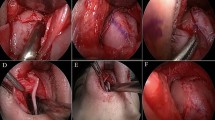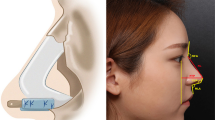Abstract
Background
Dorsum preservation rhinoplasty is a commonly performed procedure worldwide by facial plastic surgeons. Despite extensive research in measuring the outcomes of rhinoplasty, there is still no consensus on the ideal outcome. This study compares two dorsum preservation methods, namely upper septal strip excision and lower septal strip, in terms of long-term aesthetic and functional outcomes.
Methods
This prospective randomized study included 173 patients who underwent the preservation dorsum technique. The aesthetic and functional results of the upper and lower septal strip excision were analyzed. Patient satisfaction was measured using validated outcome instruments and patient-reported outcome measurements (SCHNOS). Statistical analysis was conducted to compare the outcomes of the two techniques.
Results
At the 12-month mark, upper septal strip excision demonstrated higher aesthetic evaluation compared to lower septal strip, supporting the rationale behind its development. The lower septal strip method, however, was found to be more adaptable and enabled a broader range of septal work. Upper septal strip excision showed greater efficiency in enhancing both preoperative and postoperative nasal function. Regarding postoperative nasal aesthetics, both methods appeared to be equally effective.
Conclusions
The findings of this study suggest that upper septal strip excision may be a more successful preservation technique compared to the lower septal strip method in the context of dorsum preservation rhinoplasty.
Level of evidence: Level IV, therapeutic study.


Similar content being viewed by others
References
Perkins SW, Shadfar S (2019) Complications in reductive profileplasty. Facial Plast Surg 35(05):476–485
Kamer FM, McQuown SA (1988) Revision rhinoplasty. Analysis and treatment. Arch Otolaryngol Head Neck Surg 114(03):257–266
Guyuron B, Bokhari F (1996) Patient satisfaction following rhinoplasty. Aesthet Plast Surg 20(02):153–157
Saban Y, de Salvador S (2021) Guidelines for dorsum preservation in primary rhinoplasty. Facial Plast Surg 37(01):053–064
Varoquier M, Rumeau C, Vuissoz PA, Perez M, Hossu G, Jankowski R (2021) Do the upper lateral nasal cartilages exist? The concept of septolateral cartilages. Eur Ann Otorhinolaryngol Head Neck Dis 138(2):77–81
Patel PN, Kandathil CK, Abdelhamid AS, Buba CM, Most SP (2023) Matched cohort comparison of dorsal preservation and conventional hump resection rhinoplasty. Aesthet Plast Surg 47(3):1119–1129
Daniel RK (2018) The preservation rhinoplasty: a new rhinoplasty revolution. Aesthet Surg J 38(2):228–229
Tham T, Bhuiya S, Wong A, Zhu D, Romo T, Georgolios A (2022) Clinical outcomes in dorsal preservation rhinoplasty: a meta-analysis. Facial Plast Surg Aesthet Med 25(3):187–194
Goodale JL (1899) A new method for the operative correction of exaggerated Roman nose. Boston Med Surg J 140(112):1899
Gonçalves Ferreira M, Toriumi DM (2021) A practical classification system for dorsal preservation rhinoplasty techniques. Facial Plast Surg Aesthet Med 23(3):153–155
Saban Y et al (2018) Dorsal preservation: the push down technique reassessed. Aesthetic Surg J 38(2):117–131
Ishida J, Ishida LC, Ishida LH et al (1999) Treatment of thevnasal hump with preservation of the cartilaginous framework. Plast Reconstr Surg 103:1729–33 (discussion: 1734–5)
Finochi V (2020) SPQR technique: simplified preservation of quick rhinoplasty. Med Jadertina 50(1):14–14
Cottle MH, Loring RM (1946) Corrective surgery of theexternal nasal pyramid and the nasal septum for restoration of normal physiology. Ill Med J 90:119–135
Moubayed SP, Ioannidis JP, Saltychev M, Most SP (2018) The 10-item Standardized Cosmesis and Health Nasal Outcomes Survey (SCHNOS) for functional and cosmetic rhinoplasty. JAMA Facial Plast Surg 20(1):37–42
van Zijl FVWJ, Mokkink LB, Haagsma JA, Datema FR (2019) Evaluation of measurement properties of patient-reported outcome measures after rhinoplasty: a systematic review. JAMA Facial Plast Surg 21:152–162
Kandathil CK, Saltychev M, Patel PN, Most SP (2021) Natural history of the standardized cosmesis and health nasal outcomes survey after rhinoplasty. Laryngoscope 131(1):E116–E123
Tas S (2022) Rhinoplasty in practice: an algorithmic approach to modern surgical techniques. CRC Press, Boca Raton
Qaradaxi KA, Mohammed AA (2023) Functional and aesthetic outcomes of no dissection nasal dorsum using sub dorsal septal excision in preservation rhinoplasty. Plast Reconstr Surg e010335. https://doi.org/10.1097/PRS.0000000000010335
Saban Y, de Salvador S (2021) Guidelines for dorsum preservation in primary rhinoplasty. Facial Plast Surg 37(01):053–064
Qaradaxi KA, Mohammed AA, Mohammed HN (2022) The outcome of V vs. S shaped nasal deformity in preservation rhinoplasty; a comparative study. Ann Chir Plast Esthét 67(4):239–244
Tham T, Bhuiya S, Wong A, Zhu D, Romo T, Georgolios A (2022) Clinical outcomes in dorsal preservation rhinoplasty: a meta-analysis. Facial Plast Surg Aesthet Med 25(3):187–194
Funding
The authors received no financial support for publication of this article.
Author information
Authors and Affiliations
Corresponding author
Ethics declarations
Ethical approval
All procedures performed in studies involving human participants were in accordance with the ethical standards of the institutional and/or national research committee and with the 1964 Helsinki Declaration and its later amendments or comparable ethical standards. This study was approved by the Ethical Committee and Research Registration of Duhok Medical College (reference No. 07122-9-2).
Conflict of interest
Kurdo A. Qaradaxi declares no competing interests.
Patient consent
Informed written consent was taken from each patient to be enrolled in the current study.
Additional information
Publisher's note
Springer Nature remains neutral with regard to jurisdictional claims in published maps and institutional affiliations.
Rights and permissions
Springer Nature or its licensor (e.g. a society or other partner) holds exclusive rights to this article under a publishing agreement with the author(s) or other rightsholder(s); author self-archiving of the accepted manuscript version of this article is solely governed by the terms of such publishing agreement and applicable law.
About this article
Cite this article
Qaradaxi, K.A. Dorsum preservation rhinoplasty: a matched cohort comparison of upper and lower septal excision techniques. Eur J Plast Surg 46, 985–992 (2023). https://doi.org/10.1007/s00238-023-02110-z
Received:
Accepted:
Published:
Issue Date:
DOI: https://doi.org/10.1007/s00238-023-02110-z




